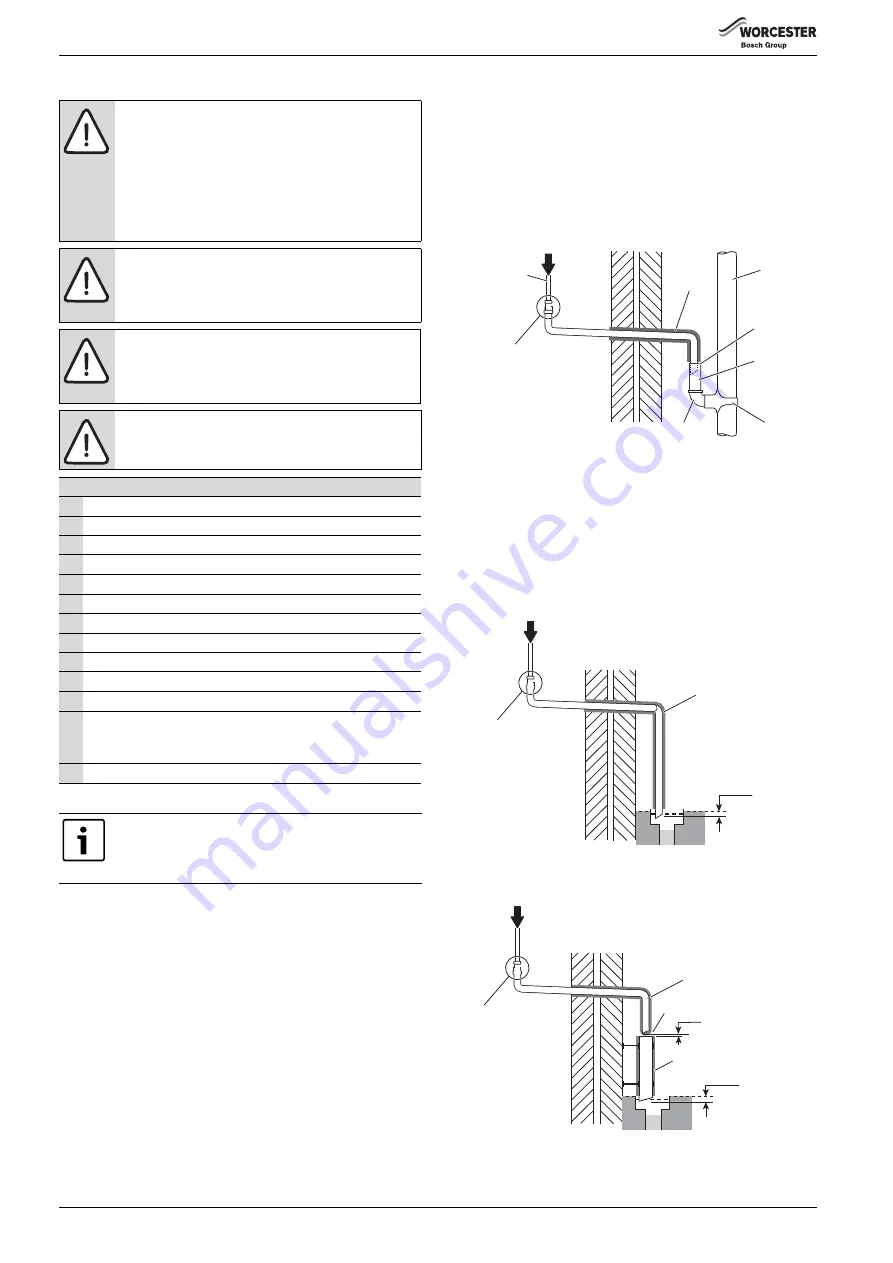
Pre-Installation
Greenstar Utility
ErP -
6 720 821 751 (2018/04)
14
4.5.3
External connections
If no other discharge method is possible then the use of an externally run
condensate drainage pipe terminating at a suitable foul water discharge
point, or purpose-built soak away, may be considered. If this method is
chosen then the following measures should be adopted:
▶ The external run be kept as short as possible and not exceed 3
metres.
▶ The pipe should be run internally as far as possible before going
externally and the pipe diameter should be increased to 32mm
before it passes through the wall to the exterior. The pipe should be
insulated using suitable waterproof and weather resistant insulation,
if not using a CondenseSure siphon.
▶ The external pipe should take the shortest and least exposed route to
the discharge point, and should "fall" as steeply as possible away
from the appliance, with no horizontal runs in which condensate
might stand.
▶ The use of fittings, elbows etc. should be kept to a minimum and any
internal “burrs” on cut pipe work should be removed so that the
internal pipe section is as smooth as possible.
FITTING AN EXTERNAL AIR BREAK
• Refer to figure 13 when a rain water down pipe is used to dispose of
condensate.
• An air break must be installed in the 43mm pipe work, between the
appliance condensate outlet and the drainpipe, outside the property,
to avoid flooding during adverse weather conditions.
Fig. 13 Disposal into a rainwater down pipe
Where the pipe terminates over an open drain or gully, the pipe should
terminate below the grating level, but above water level, in order to
minimise “wind chill” at the open end.
The use of a drain cover (such as those used to prevent blockage by
leaves) may offer further protection from wind chill.
Pipe drainage will be improved if the end is cut at 45° as opposed to a
straight cut.
Fig. 14 External disposal
Fig. 15 External disposal with an air break
NOTICE:
Rainwater or external drain disposal
Untreated condensate must not be allowed to flow into
streams or rivers
▶ A rainwater down pipe or an external drain shall only
be used for condensate disposal it the down pipe or
external drain is connected to a combined foul and
rainwater system
▶ Refer to BS 5410 for more information
NOTICE:
Grey water systems
Contamination of recovered water
▶ Condensate disposal shall not be allowed into a grey
water recovery system that is intended for re-use
NOTICE:
Freezing conditions
▶ Pipe work length should be kept to a minimum and the
route as vertical as possible.
▶ When required, use only weather proof insulation.
NOTICE:
Condensate waste
▶ Care should be taken when siting a soak-away to
avoid obstructing existing services.
Continued - Key to illustrations
, figures 13,14, 15, 16 & 17
8
Pipe work transition
9
Insulate and increase pipe size
10 External rain water pipe into foul water
11 External air break
12 Air gap
13 PVCu strap-on fitting
14 43mm 90 male/female bend
15 100mm Ø minimum plastic pipe
16 Drainage holes
17 Limestone chippings (25kg minimum)
18 Bottom of sealed tube
19 Increase soak away size and the area with limestone chippings if
in clay soil area.
Not recommended for high clay soil areas.
20 Increase pipe size to next size up from discharge pipe
Table 6 Key to external condensate disposal methods
Condensate drainage pipe can be run above or below
ground. If the pipe work is run under ground, care must
be taken to ensure that the pipe work “fall” towards the
disposal point is maintained
6720810188-05.5
21.5mm Ø
9
10
11
12
13
14
8
1
6720644744-10.5Wo
9
25mm min.
1
8
6720819188-13.1Wo
9
25mm min.
1
8
10mm min.
20
11















































